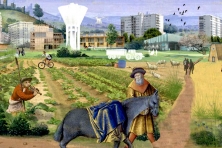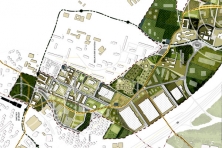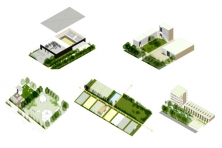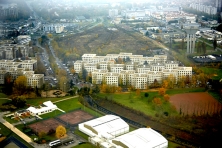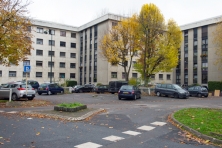Terres vives, les nouveaux communaux
Grigny & Ris-Orangis (FR) - Mentionné
DONNÉES DE L’ÉQUIPE
Représentante d’équipe: Maia Tüür (EE) – architect et urbaniste
Associé: Yoann Dupouy (FR) – architecte et urbaniste
TU-DU Architecture Urbanisme
95 rue de la Roquette, 75011 Paris (FR)
contact@tu-du.fr - tu-du.fr
Voir la liste complète des portraits ici
Voir la page du site ici

M. Tüür & Y. Dupouy
INTERVIEW en anglais
Cliquer sur les images pour les agrandir
1. How did you form the team for the competition?
Since 2014 we have been working together via our office TU-DU Architecture Urbanisme.
2. How do you define the main issue of your project, and how did you answer on this session main topic: the place of productive activities within the city?
Our first impression of the site was marked by a succession of several fences related to physical and administrative boundaries (municipalities, ZAC…). This particularity revealed the importance of the land use policy for this site. Therefore we considered that an alternative land policy should be one of the key elements of our project, a tool to create a different way to develop this in-between "productive city" made of connections and exchanges. Actually this is the main question of our project.
3. How did this issue and the questions raised by the site mutation meet?
We consider the question of "productive city" in a holistic sense. The site has been developed according a logic of juxtaposition of disconnected urban fragments. We suggest that the "productive city" might be generated by multiplying connections and exchanges between the existing fragments and areas to develop. Therefore our approach did not fit into the limits of the activity zone "Les Terres Saint-Lazare", given as a site of Europan. The question concerned a general vision of mutation to come for a wide strategic territory with high environmental value.
4. Have you treated this issue previously? What were the reference projects that inspired yours?
The fragmentation of the site is based on the repartition of different "landlords" with different interests. We were looking for a way to soften the fragmentation by inviting the inhabitants and the newcomers to go beyond the limits. The network, beyond the boundaries, is behind the productivity of the territory.
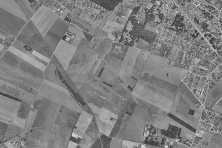
5. Urban-architectural projects like the ones in Europan can only be implemented together with the actors through a negotiated process and in time. How did you consider this issue in your project?
This is our first time to "base" a project on a question of land use management. Actually it seems to us that the question is about to become a major issue for an urban project, a tool with a potential to generate innovation. We were inspired by the experiences of the "Community Land Trust". The idea is fundamental in our proposal. The institution "Terres Vives" generates discussions and negotiations between different actors of the territory. The question is quite simple: how to imagine a mutation for the site otherwise then by developing wide disconnected juxtaposed sectors? In other words, how to encourage multiple matches and crossings of different users? How to develop a common use?
6. Is it the first time you have been awarded a prize at Europan? How could this help you in your professional career?
We have had a chance to be among the laureates of the two previous sessions of Europan. It has been for us an occasion to meet different actors of urban projects, but also a lot of young professionals all around Europe.
